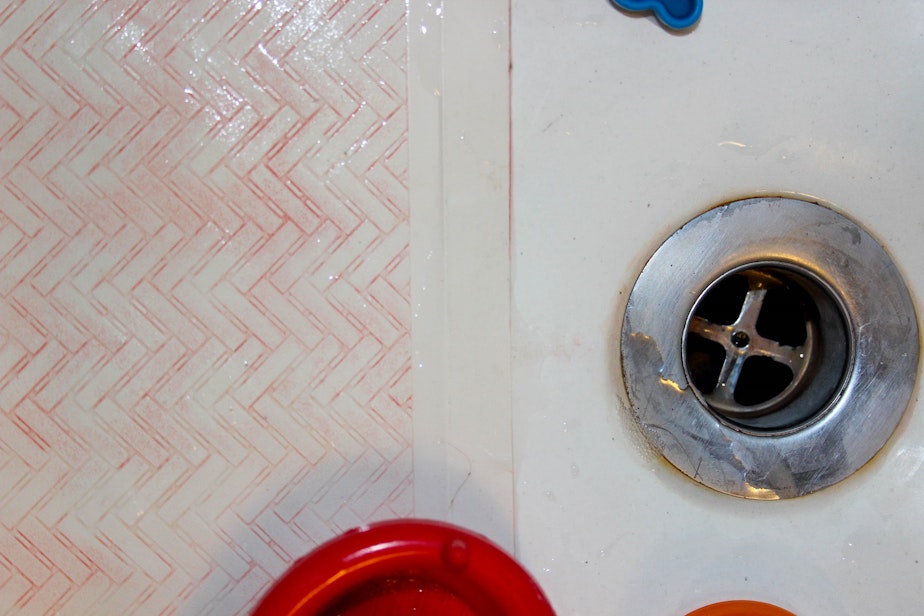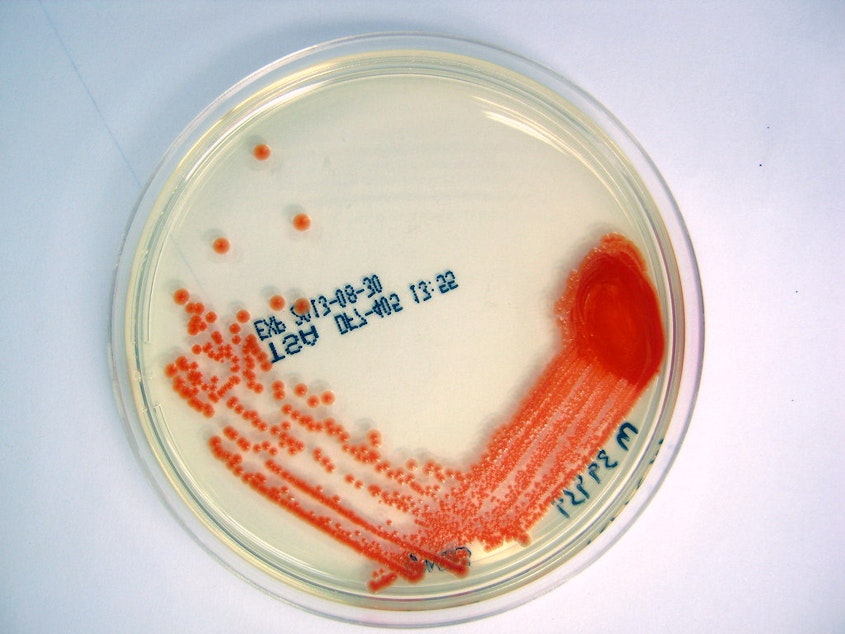Why won't this pink stuff stop growing in my bathroom?

You see them when you slack on cleaning — mysterious pink rings and streaks that form in your toilets, sinks and bathtubs.
The Record's Bill Radke speaks with reporter Amy Rolph about the bizarre story she uncovered when asked to investigate the mysterious pink goo in Seattle bathrooms.
KUOW Local Wonder listener John Logic wanted to know if that pink slime is unique to the Pacific Northwest: “I've lived here 25 years,” he wrote us. “WHY is there a red tint that occurs in the toilet bowls of my homes? Even replaced my water line. Not my diet. Why?”
Logic also asked if the substance is dangerous, wondering if it could be related to the region’s high rate of multiple sclerosis.
The short answer: Seattle is not alone in getting slimed. Those pink rings and streaks are a biofilm formed by colonies of a bacterium called Serratia marcescens, found worldwide. Like most bacteria, it’s harmless — unless you’re in extremely poor health.
Now, the long answer: That red-tinged bathroom gunk is related to an exorcism, Italy’s “bloody polenta” epidemic of 1819 and, years later in the U.S., a dangerous government experiment.
Those pink rings are alive, they are everywhere, but they are not mold.
You can find Serratia marcescens abundantly on Earth, including in water or dirt. These microbes love wet surfaces, and they go crazy if that damp spot also contains phosphorus or fatty residue such as soap or shampoo.
Since Serratia marcescens is airborne, it’s possible that you might notice more pink slime around your home during warm weather when your windows are open. Or, if you use a water filter that removes chlorine, you might find that your sinks, bathtubs and toilets are more hospitable to the bacterium.
Jack Gilbert, a microbial ecologist at the University of Chicago, said it’s likely that Serratia marcescens exists in similar levels in homes all over the world, although he doesn’t know of conclusive data measuring levels by region.
“It will grow when there is sufficient water around, and it’s there, in damp places with little competition from other microbes, that it’s likely to become abundant,” Gilbert said.
For healthy people, Serratia marcescens poses no health risks, although Gilbert advises using a healthy dose of common sense. Rubbing pink slime from your shower wall into your eyes would probably be a bad idea, especially since Serratia marcescens has been known to contaminate contact lenses and cause irritation or eye infections.
In the beginning, Serratia marcescens’ red pigment caused panic in Italy.
Serratia marcescens wasn’t officially discovered until 1819, when residents in one Italian province became fearful of “bloody” polenta during a particularly humid summer.
“Families refused to stay in homes where the discolored polenta was kept, and one farmer asked for a priest to free his home from ‘evil spirits,’” writes microbiologist Steven Mahlen.
Were those Italian farmers showing good sense in avoiding contaminated food? Dr. Paul Pottinger, an infectious diseases expert with UW Medicine in Seattle, said Serratia marcescens is less of a threat when ingested than when it enters parts of the body that should be sterile, such as the lungs, blood or brain.
“Based on all the history of how this germ has been found in food, you would think it would be a real issue for human health,” Pottinger said. “However, Serratia is not notorious as a source of gastrointestinal infection.”
Modern-day historians and scientists theorize that Serratia marcescens has long had a dramatic relationship with food, as it was likely mistaken for blood throughout history. The bacterium could be responsible for “bleeding bread” miracles throughout religious history, since it loves starch as much as it loves the soap scum on your shower wall. And bleeding statues? That could be Serratia marcescens, too.
Perhaps the truly miraculous thing about Serratia marcescens: The red pigment it produces (aptly named prodigiosin) seems to have cancer-fighting properties, although the exact nature of how it interacts with malignant cells is still being studied.

In rare cases, Serratia marcescens can be deadly.
If you type “Serratia marcescens” into your favorite search engine, you might find some pretty scary stuff about hospital infections. Along with other bacteria, Serratia marcescens is a source of hospital-acquired infections, which can happen if a patient’s immune system is severely compromised or if the bacterium enters the body with a catheter, respirator or other medical device.
“If it gets into your bloodstream, it can cause trouble,” Pottinger said.
Hospital-acquired infections were responsible for 75,000 deaths in the U.S. in 2011, according to the Centers for Disease Control and Prevention. Overall, infection rates are trending down, likely due to caregiver guidelines that include more frequent handwashing and sanitation of equipment.
But for relatively healthy people eying their pink-tinged bathtub drain and wondering if the water is really safe, Pottinger said there’s probably nothing to worry about. Bacteria is everywhere, after all; this bacteria just happens to be visible without a microscope.
“We share the world with these microbes,” Pottinger said. “It’s just once in a blue moon that they actually cause trouble.”
Before the deadly side of Serratia marcescens was known, the government sprayed it on unsuspecting Americans.
Until the 1950s, Serratia marcescens was thought to be harmless. That, coupled with its easily trackable red pigment, made it a go-to choice for the federal government when testing the possible impact of biological warfare.
In 1950, the U.S. Navy secretly sprayed Serratia marcescens into the air just off the coast of San Francisco. Called Operation Sea Spray, the covert experiment was one of several similar tests conducted by the U.S. government in the 1950s and ’60s. This one was meant to simulate an off-shore bioweapon attack on a major American city, with the goal of tracking how the brightly-colored bacteria spread.
Within a month of the tests, 11 people checked into a San Francisco hospital with infections. One patient, a 75-year-old man named Edward Nevin who was recovering from prostate surgery, eventually died. San Francisco hospitals also reported an uptick in pneumonia cases following the tests, although a direct correlation with the Navy tests was never established.
Defense officials acknowledged Operation Sea Spray during a Senate subcommittee hearing in 1977 after journalists uncovered evidence of the tests. Nevin’s family tried unsuccessfully to sue the federal government for wrongful death.
''We are far more concerned about principle than about monetary damages,'' Nevin’s grandson said in a 1981 New York Times article. ''We have been motivated by the horrible specter of the government conducting potentially fatal tests on an uninformed public.''
Decades later, some doctors and scientists theorize that Operation Sea Spray could have altered the Bay Area’s microbial ecology, possibly resulting in more infections.
Are we doomed to pink toilets and showers?
You’ve read this story, but what you really want to know is how to get rid of it? Fair enough.
Gilbert, the microbiologist, recommends dousing the pink stuff with a cleaning product containing bleach. But just know that Serratia marcescens is a persistent form of life, and it will almost definitely be back — so keep that toilet brush handy.
Submit questions about our region in the form below. Your question could be investigated in a future KUOW story.
This story was originally published on KUOW.org December 7, 2016.
